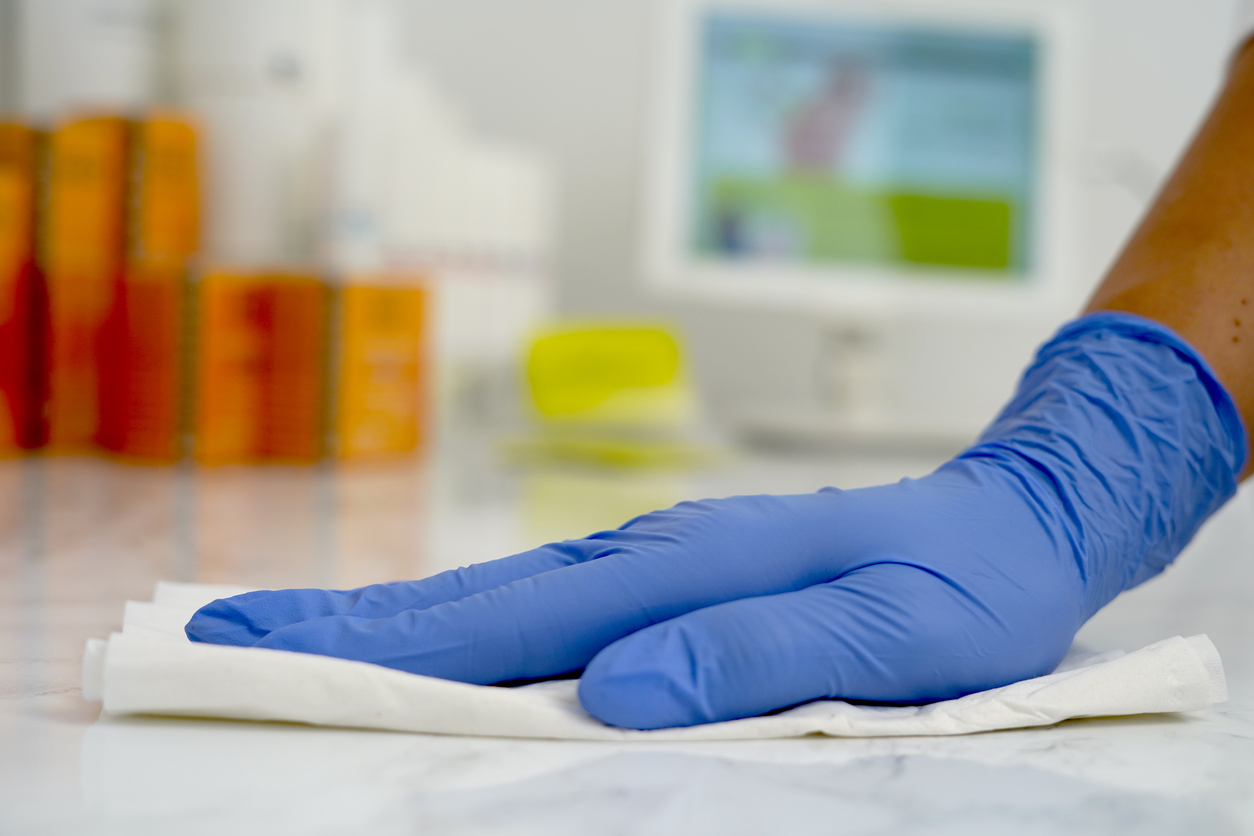
Share On Social!
We know germs can cause illnesses.
We also know that frontline healthcare workers can take action to protect themselves, their colleagues, and their patients from infectious disease threats.
Cleaning and disinfecting are two of these important actions for infection control.
A fundamental part of this process is “contact time.” This is the amount of time a disinfectant must sit on a surface, without being wiped away or disturbed.
Contact time allows the disinfectant to do its job: Killing germs.
“There are a lot of germs in healthcare. That’s no surprise to any of us,” said Dr. Abigail Carlson, an infectious diseases physician with the U.S. Centers for Disease Control and Prevention (CDC), as part of CDC Project Firstline’s Inside Infection Control video series.
“And, quite obviously, we don’t want them to spread around to our patients or to others. When we disinfect surfaces, like bed rails and door handles, or when we disinfect equipment, like stethoscopes and other devices, all of that is a huge part of infection control. That’s why it’s important to disinfect correctly.”
Contact Time and Its Impact on Disinfection in Healthcare Settings
Anytime a healthcare worker cleans and/or disinfects a room, surface, or other area, it is important for those workers to read and understand the exact instructions on product labels before use.
According to the CDC, this is critical because:
- It takes time for some products to kill germs, and for the surface or device to be fully disinfected.
- Contact time can vary depending on the product you are using.
- Products that both clean and disinfect still have a contact time that you need to use for it to work correctly.
 “You have to know what the chemical can be used on, which surfaces it can be used on before you use it,” Carlson said. “You have to know which germs it’s been proven to kill so that you’re using it in the right place at the right time. And you need to know if it needs to be diluted, which means adding water to it to take the concentration down to a safe concentration and a correct concentration for killing germs. It’s a little bit like cooking. You want to use the right ingredients and follow the recipe.”
“You have to know what the chemical can be used on, which surfaces it can be used on before you use it,” Carlson said. “You have to know which germs it’s been proven to kill so that you’re using it in the right place at the right time. And you need to know if it needs to be diluted, which means adding water to it to take the concentration down to a safe concentration and a correct concentration for killing germs. It’s a little bit like cooking. You want to use the right ingredients and follow the recipe.”
It can be challenging in a busy healthcare setting, but it is important to wait for the full contact time to finish to be sure the germs are killed.
CDC also notes:
- Do not wipe the surface with another cloth before it’s dry.
- Do not blow on it with your breath to try to dry it off.
- Do not blow air on it another way, like with a fan, unless the maker of the product says it’s okay to do that.
- If you are in a dry environment, the product can dry too fast, before the contact time is up – then follow the label instructions on what to do if that happens.
“The product that you’re using might not kill germs right away,” Carlson said. “It actually takes time for germs to react with the chemical in the product and get that killing effect on the germs before we can say that something is truly disinfected.
How Contact Time Impacts Patient Turnover
Contact time is critical for proper disinfection as patients leave and enter healthcare settings.
Before a new patient can enter a room, and before shared equipment can be used again, healthcare workers should wait for the entire contact time to pass so that the disinfectant has enough time to kill germs.
This can be difficult when you have patients waiting for rooms and equipment, but not waiting for the contact time to finish can cause germs to spread to other patients or staff. If you’re a supervisor or other leader, your plans for room or equipment turnover should include the time it takes for the disinfectant products you’ve selected for your facility to work correctly.
Here are a few other things to keep in mind:
- Never rush people to use products incorrectly just to meet a deadline or a timeline.
- Set up the process to succeed and to allow your staff time to use cleaning and disinfection products correctly.
- If turnover time is a concern, rather than using a product incorrectly, choose a different product that works best for the timeline that you need.
“The risk of spreading germs when you push room turnover or equipment turnover is just too big,” Carlson said. “That’s why it’s so important to make sure your disinfection is complete before you move onto the next patient.”
What Else Can You Do to Promote Infection Control?
Healthcare workers can learn more thanks to CDC’s Project Firstline.
Project Firstline is a training and education collaborative designed to ensure all healthcare workers, no matter their role or educational background, have the infection control knowledge and understanding they need and deserve to protect themselves, their patients, and their coworkers.
Salud America! at UT Health San Antonio is working with the National Hispanic Medical Association to bring Project Firstline content to frontline healthcare workers to protect themselves, their facilities, and their patients (from Latino and all communities) from infectious disease threats.
You can read these articles:
“Healthcare teams in hospitals, nursing homes, and other care settings are the front lines against the spread of infection,” said Dr. Amelie G. Ramirez, director of Salud America! at UT Health San Antonio. “CDC’s Project Firstline is bolstering those efforts by developing evidence-based tools that can be delivered in a variety of ways to make infection control learning convenient and accessible for busy healthcare staff.”
LEARN MORE ABOUT PROJECT FIRSTLINE!
Editor’s Note: This article is part of a collaboration between Salud America!, the National Hispanic Medical Association, and the CDC’s Project Firstline. To find resources training materials, and other tools to bolster knowledge and practice of infection control, visit Project Firstline and view Salud America!’s infection control content.
By The Numbers
142
Percent
Expected rise in Latino cancer cases in coming years



